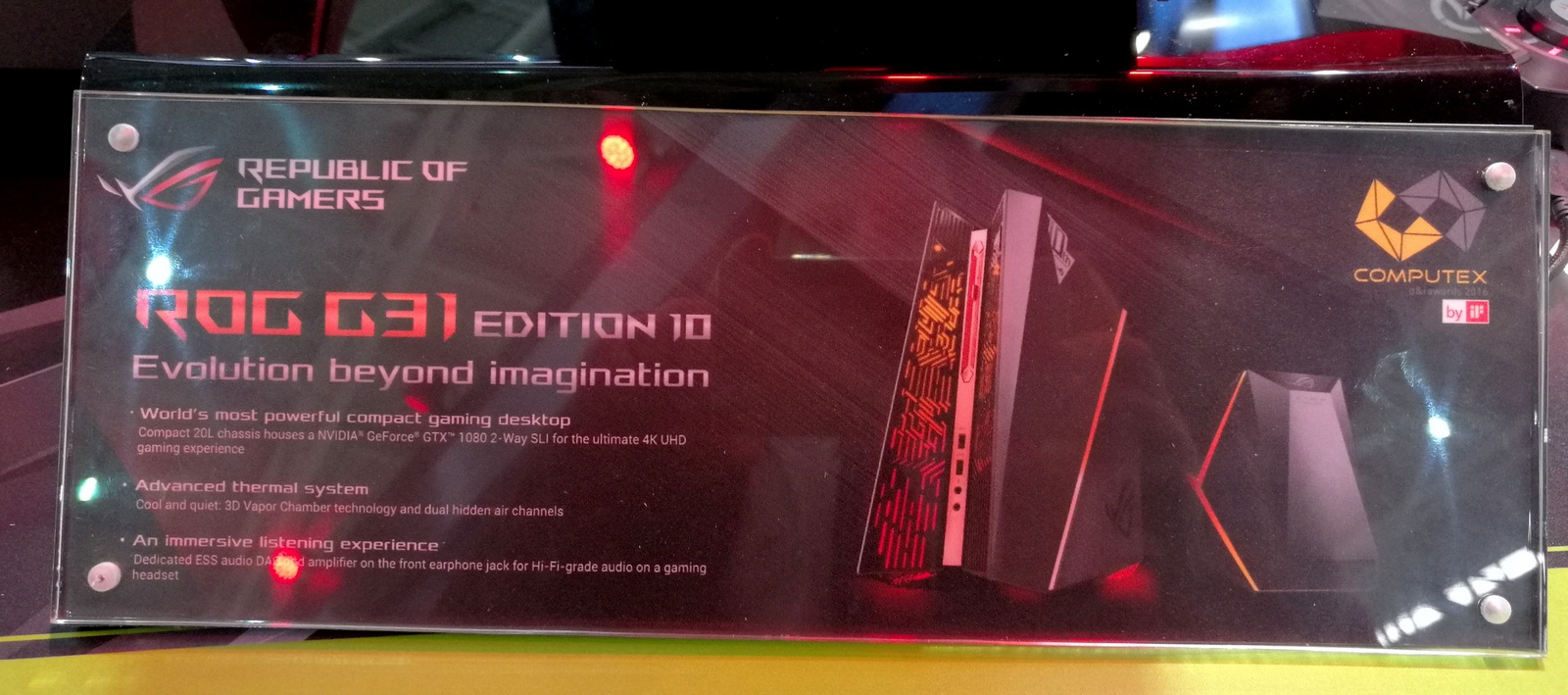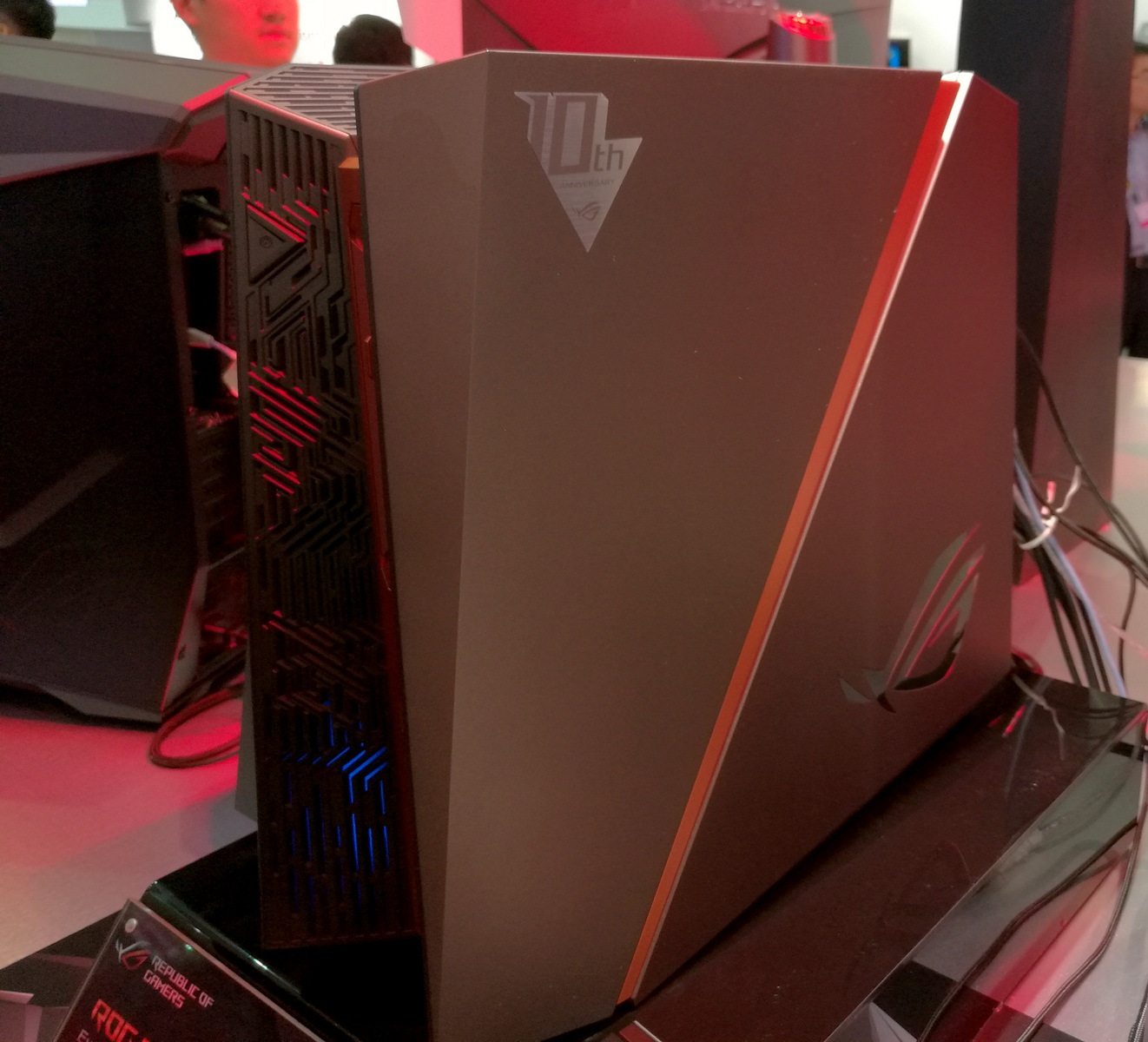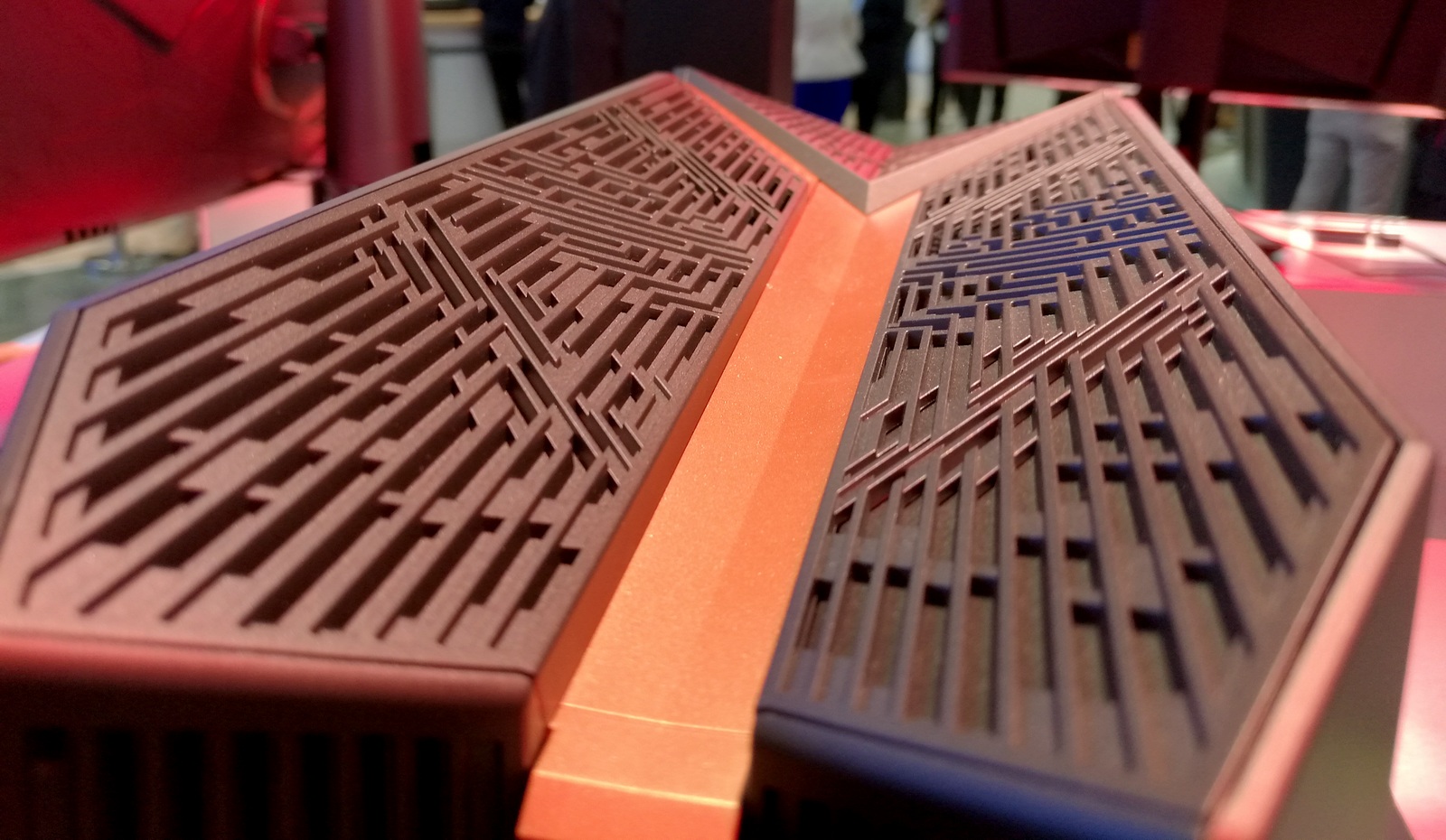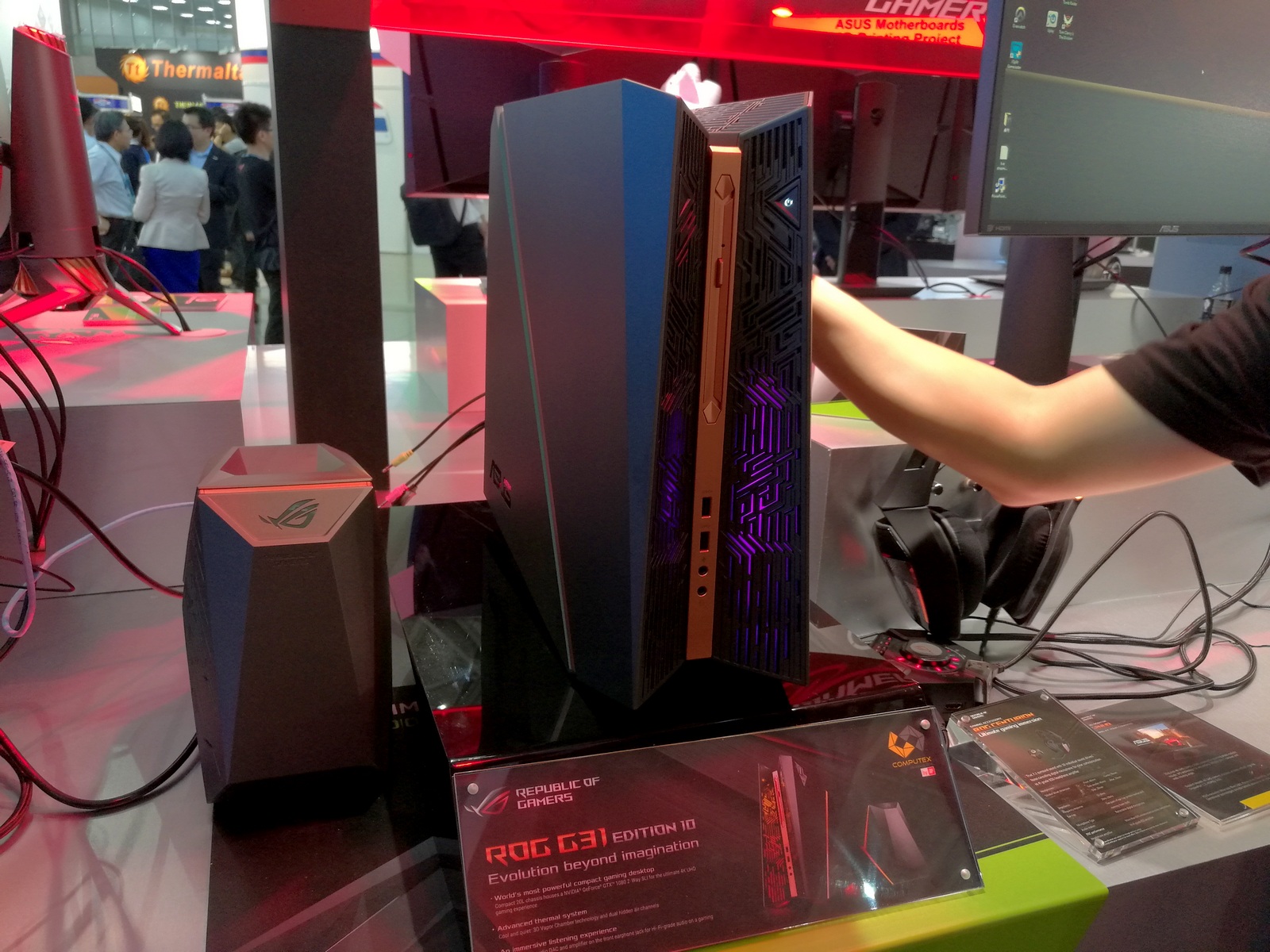ASUS at Computex 2016: The 10 Years of the Republic Of Gamers (ROG) Booth Tour
by Ian Cutress on June 22, 2016 8:00 AM ESTDesktops: ROG G31
Moving from something completely custom in the Avalon to something we’ve seen before, but upgraded. The new G31 Edition 10 is an upgraded version of the G20, a gaming desktop PC that ASUS announced last year under their Mayan-style design strategy that also included the small book-sized GR8 desktop. The G20 aimed at the crowd that wanted a different style of desktop/gaming machine, with a different look but everything pretty much integrated in a design that aimed to adjust the airflow for such a large amount of power. The G31 by comparison doubles up the number of GPUs and equips the system with the latest processors and memory.
The Edition 10 version of the G31, designed for the ROG 10-Year, will be the fully upgraded model with a 10-Year sticker on the side. This edition will house a full Core i7 (most likely the i7-6700/K), two full GTX 1080s in SLI, the Z170 chipset, support for four DDR4 memory modules and 64 GB (it’s not mentioned if they are SO-DIMM or regular), and at least two M.2 PCIe 3.0 x4 slots capable of RAID-0. To top it off, the optical disk drive at the front is also a Blu-Ray writer/DVD writer as well.
For the Edition 10, all the LEDs are RGB and additional LEDs are placed down the side stripe as well.
Being under the red lights on the show made it a bit difficult to see the LEDs, but the full chassis comes in at a 20L volume. If we compare that to the recent review of the NZKT Manta mini-ITX case from Tracy which comes in at 47L, we can see the benefits of going custom in something like this – the full motherboard and GPUs are custom for the design and are arranged to use the cooling system as efficient as possible.
Typically a PC chassis has the power supply bundled inside, however to fit this shape and design ASUS are going with an external power supply. We weren’t given an exact rating, but if we give a generous budget of 100W for the CPU, 200W each for the GPUs, 100W for everything else and then an extra 20%, then it’s probably around 720W.
No words as to pricing or release dates as of yet, but the high end ROG G20 with an i7-4790, 16GB of DRAM, a single GTX 745 and a 1TB SSD is currently retailing on Amazon for $1360. I would expect the high edition ROG G31, with dual GTX 1080 GPUs and 64GB of memory, to be nearer $4000. Of course, something like the MSI Vortex (which uses mobile GPU variants of GTX 960/970) is the competition here, and the high end version of that is $4000 as well.















43 Comments
View All Comments
Ian Cutress - Thursday, June 23, 2016 - link
It's an MSword issue when you (sometimes) insert a hyperlink. Should be fixed.Soundgardener - Sunday, June 26, 2016 - link
No; it's a technical publication issue when you forego proof-readers / copyeditors. Other examples:we waited until the following day and was able to browse the ASUS ROG Booth (we WERE not we was)
and they seem willing to be prepared to pay for it (willing / prepared: pick one, delete the other ;)
Other features such as color accuracy are also lauded by the professional community as well. (also / as well: again, only one needed...)
better color reproducibility (better colour reproduction, better colour gamut, or better colour...)
alphasquadron - Wednesday, June 22, 2016 - link
For the 240hz monitor, a good way to tell if the human eye cannot tell a difference is to test it out with professional gamers (preferably fast twitch shooters). They should be able to tell you if there is a difference or do a blind test with them. I won't listen to any more regular idiots who for the previous generation said the eye cannot tell the difference between 60hz and 120hz.Lolimaster - Wednesday, June 22, 2016 - link
The main difference people should be noticing is not about "gaming" but the thing that it reduces further more the innate flaw of the LCD/OLED sample and hold way of delivering frames vs the constantly refresh nature of CRT.OLED should starting to be called true CRT successor when every panel goes at 240Hz.
alphasquadron - Wednesday, June 22, 2016 - link
Thought anything over a 100hz had a better refresh rate than CRTs, but then again not sure.Lolimaster - Wednesday, June 22, 2016 - link
Frame time (sample and hold tech):60hz 16.66ms
120hz 8.33ms
240Hz 4.16ms
Technically you'll need about 960Hz on LCD's to achieve CRT levels of smoothness (lightboost is pretty close).
alphasquadron - Wednesday, June 22, 2016 - link
That sucks because I don't see us reaching hardware to drive 960Hz anytime soon. We just got the hardware to drive 144hz at 1080p smoothly.Gastec - Wednesday, August 31, 2016 - link
Considering that LCD monitors entered "mainstream" in 2003-2004 and that good quality 144Hz+ monitors of all resolutions are still prohibitively expensive for the average Joe, I would make a quick estimate that 960 Hz and it's driving hardware would theoretically reach our mortal realms in about 160 years.Midwayman - Thursday, June 23, 2016 - link
There are studies to say that 240hz should be usable. However there are two things. Imagine persistence is more important and they didn't explicitly state ULMB support or what refresh range it works at. Second is there is really a point of diminishing returns for refresh anyways. With a 144hz monitor the difference between 60hz and 100hz is readily apparent. Going from 100 to 144hz less so. I imagine the jump to 240hz even less important.Bragabondio - Wednesday, June 22, 2016 - link
Can anybody explain me why for God's sake there millions of updated LGA 2011-v3 motherboards but only in ATX size!?! I was patiently waiting to build a new Broadwell E PC with micro ATX or even mini ITX board and there is not a single micro ATX that has all the new features of their big brother (some don't have USB 3.1 other have the M.2 in the older PCI 2 format - not much faster than the SATA 3 etc.) Even going for z170 ( can't believe I will be upgrading to 4 core CPU after 6 years of 4 core CPU - core i7 870!) and there are just a few micro ATX z170 boards with all the new features.I am not going back to gigantic ATX case - thank you very much, so I am left with the choice of either not upgrading (I gave my old PC to my mom so currently I use MS Surface pro with a dock that works well for office work not so much for gaming) , wait for ZEN, buy a laptop that supports external video card dock (laptop + dock would probably take the same space and would have zero upgradability - except for the video card) or cave up and get core i7 6700k.
So I don't understand why manufacturers don't want my money?